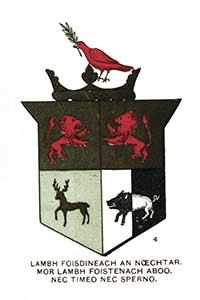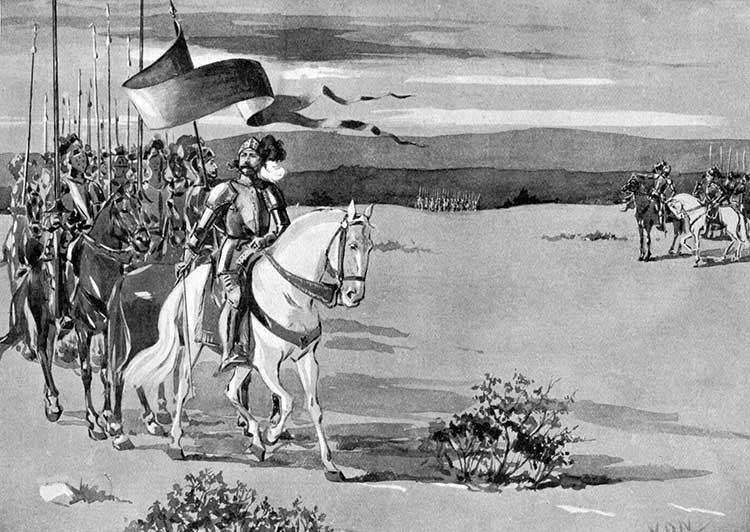The Sullivan Family

(Crest No. 4. Plate 1.)
WHO will hold back when O’Sullivan, loudly,
Calls on his people to haste to his aid?
Who will not rush to him, gladly and proudly,
Fire in his heart and an edge on his blade?
Kindred! clansmen!
Seamen and landsmen!
Young men and old men, afar and anear,
Together! together!
In calm or wild weather,
When called by the shout of O’Sullivan Beare!
Never a coward, a cringer or quailer,
Was chieftain of Beara of late or of yore;
Ever a hero, a soldier and sailor
Fearless at sea and valiant on shore!
Landsmen! seamen!
Fearless and free men,
Namesake and kinsman afar and anear,
Together! together!
From sea-foam and heather,
Come to the call of O’Sullivan Beare!
Come with a rush when O’Sullivan needs you,
Worthy your cheerful devotion is he,
Gayly dash on where O’Sullivan leads you,
Fearing not, caring not, where it may be!
Tall men! small men!
Stout men and all men!
Horsemen and boatmen afar and anear,
Together! together!
In calm or wild weather,
When called by the shout of O’Sullivan Beare!
T. D. Sullivan.
The O’Sullivan family is descended from Milesius, King of Spain, through the line of Heber, third son of that monarch. The original name was Suilleachain, and signifies “Quicksighted.” The surname was taken from Suilleabhain, a chief, A. D. 950. The founder of the family was Cormac, King of Munster, A. D. 483, of the race of Eogan More.

O’SULLIVAN’S RIDE TO THE DESMOND’S GATHERING.
“There rides the fierce O’Sullivan from tempest-lashed Ivera.”
The territory of the O’Sullivans was located in the present Counties of Cork, Kerry and Limerick, and the chiefs of the sept bore the title of Prince of Fin Fochta and Beare, and Lord of Dunkerron. The sept of the O’Sullivans included the families of the O’Sullivan More and O’Sullivan Beare, the McGillicudys and the O’Flavins. Originally the family was located along the River Suir, in the County of Tipperary, in the locality of Clonmel and Knockgraffon, but after the Anglo-Norman invasion they moved to Cork and Kerry, possessing the baronies of Beare and Bantry in the former, and Iveragh, Dunkerron and Glanarough in the latter county. The family was known under the two branches of the O’Sullivan More and O’Sullivan Beare. It has occupied a foremost place in Irish history from the beginning, and affords an illustration of the truth that talent runs in families.
In the Cromwellian and Williamite wars the O’Sullivans fought bravely for their possessions and their country, but eventually they were despoiled of their remaining lands. Dunloe Castle, in the County of Kerry, was a stronghold of the O’Sullivan More, and withstood a siege against Cromwell’s forces. The defense of the Castle of Dunboy, the stronghold of Donnell O’Sullivan Beare, against the forces of Sir George Carew, during the reign of Elizabeth, is one of the most thrilling episodes in Irish history. The castle was defended by 143 men, while the besiegers numbered nearly 4,000. Notwithstanding the disparity in number and arms, the garrison held out for two weeks, inflicting fearful loss on the enemy; fighting from turret to turret, and stone to stone as the walls were crumbled about them, and at last retreating to the cellar, where one of the defenders, the heroic MacGeoghegan, though mortally wounded, was dragging himself to where nine barrels of gunpowder were stored, with a lighted torch in his hand to blow up the enemy, his companions and himself when killed by the enemy. None of the 143 defenders escaped.

O’SULLIVAN,
Earl of Bear and Bantry.
[From an original painting in the Irish College, Salamanca, Spain.]
The famous retreat of Donnell O’Sullivan from Glengariff to Rourke’s Castle, in Leitrim, during the campaign of Sir George Carew, is unsurpassed in military annals. With 400 fighting men and 600 women, children and servants he set out, marching and fighting night and day, attacked constantly and on all sides by superior numbers, and managed to cut his way forward, bringing with him his disabled and wounded when possible. He crossed the Shannon in currachs made of his horses’ skins, and defeated the English forces, killing their commander, Manby, and finally fought his way to Rourke’s Castle. On reaching his destination his force was reduced to eighteen fighting men, sixteen servants and one woman. Among the survivors were the father and mother of the famous Philip O’Sullivan Beare of the Spanish navy, and one of the most eloquent writers of the age, and his brother Daniel, who fell fighting the Turks. Donnell O’Sullivan afterward went to Spain, where he was appointed Governor of Corunna and Viscount Berehavan. He was assassinated by his English servant whom he had befriended and cared for, while returning from mass, July 16, 1618, in the fifty-ninth year of his age.
In their account of O’Sullivan’s retreat into Ulster, the Four Masters say: “He was not a day or night during that space without encountering desperate conflicts and severe pursuits, which were valiantly and promptly resisted by him.” The Abbé MacGeoghegan, in his History of Ireland, says: “We read nothing more like to the expedition of Young Cyrus and the Ten Thousand Greeks than this retreat of O’Sullivan Beare.” A detailed account of the incident is given in the Annals of the Four Masters, and in the “Historiæ Catholicæ Iberniæ Compendium” of Don O’Sullivan Beare.
After the confiscation of their extensive possessions during the reign of James the First, the heads of the O’Sullivan family retired to Spain, where many of them acquired high military and civil honors. Members of this distinguished family also won titles and honors in Belgium and Germany and Naples, and were honorably represented in the various regiments of the Irish Brigade in the service of France.
Another distinguished scion of this family was Colonel John O’Sullivan, who attended Prince Charles Stuart in his expedition to recover his throne, and acted as the Prince’s military adviser and aid. With a few hundred Highlanders O’Sullivan not only overran the most of Scotland, but a part of England itself, and for a time made the contest a very doubtful one. He served in the French army in Corsica, in Italy, and on the Rhine, and with such success that a French general said that he understood the art of irregular warfare better than any man in Europe, while his knowledge of regular warfare was not much inferior to that of any general then living. His son Thomas was an officer in the Irish Brigade, and afterward became a major in the Dutch service, where he died, 1824.
Sir Richard Joseph Sullivan, born in Ireland in the middle of the eighteenth century, was for many years in the service of the East India Company, and published a number of volumes on various subjects. Francis S. Sullivan, who was born in the South of Ireland, and died in 1775, was the author of learned works on “Feudal Law” and the “Constitution and Laws of England.” Robert Sullivan, LL. D., born in 1800, was the author of a “Dictionary of the English Language” and a number of educational works that have gone through many editions, and still have an extensive circulation.
In the history of the United States the name of this family has acquired added luster. General John J. Sullivan, in December, 1774, with John Langdon, captured Fort William and Mary, with all its munitions and stores, being the first act of armed hostility in the war of Independence. He was created brigadier-general, and afterward major-general by Congress, and on August 27, 1776, was largely instrumental in saving the American army on Long Island. He led his command with signal success at Trenton and Brandywine; defeated the British left at Germantown, and the Tories and Indians in Western New York under Johnson and Brandt. He sat in the first General Congress, 1774, and was also a member of Congress from 1782 to 1786. He was subsequently attorney-general and “president” of the State of New Hampshire, and secured the ratification of the Federal Constitution by his State. His son George was a distinguished lawyer, and served as a member of the Legislature, of Congress and as Attorney-General of the State. James Sullivan was a brother of the latter; was Judge of the Superior Court of Massachusetts; member of the convention which framed the State Constitution; member of Congress and Governor of the State. His son, William Sullivan, was a member of the Legislature for years, and published a number of historical works. His brother, John Langdon Sullivan, a distinguished engineer, was the inventor of the steam tow-boat, having received a patent for it in 1814. Robert Fulton applied for a patent at the same time, but Sullivan’s priority was sustained. The name is very numerous in Ireland and America, where many of the family have acquired wealth and honorable position. Among the latter may be mentioned the Hon. John A. Sullivan, Collector of Internal Revenue, New York; Mr. Andrew T. Sullivan, Postmaster, Brooklyn, N. Y., and Counselor William Sullivan of the same city.
